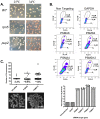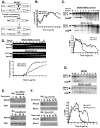Proteasome nuclear activity affects chromosome stability by controlling the turnover of Mms22, a protein important for DNA repair
- PMID: 20174551
- PMCID: PMC2824753
- DOI: 10.1371/journal.pgen.1000852
Proteasome nuclear activity affects chromosome stability by controlling the turnover of Mms22, a protein important for DNA repair
Abstract
To expand the known spectrum of genes that maintain genome stability, we screened a recently released collection of temperature sensitive (Ts) yeast mutants for a chromosome instability (CIN) phenotype. Proteasome subunit genes represented a major functional group, and subsequent analysis demonstrated an evolutionarily conserved role in CIN. Analysis of individual proteasome core and lid subunit mutations showed that the CIN phenotype at semi-permissive temperature is associated with failure of subunit localization to the nucleus. The resultant proteasome dysfunction affects chromosome stability by impairing the kinetics of double strand break (DSB) repair. We show that the DNA repair protein Mms22 is required for DSB repair, and recruited to chromatin in a ubiquitin-dependent manner as a result of DNA damage. Moreover, subsequent proteasome-mediated degradation of Mms22 is necessary and sufficient for cell cycle progression through the G(2)/M arrest induced by DNA damage. Our results demonstrate for the first time that a double strand break repair protein is a proteasome target, and thus link nuclear proteasomal activity and DSB repair.
Conflict of interest statement
The authors have declared that no competing interests exist.
Figures






Similar articles
-
Inhibition of proteasomal degradation of rpn4 impairs nonhomologous end-joining repair of DNA double-strand breaks.PLoS One. 2010 Apr 1;5(4):e9877. doi: 10.1371/journal.pone.0009877. PLoS One. 2010. PMID: 20376190 Free PMC article.
-
Delineation of the role of chromatin assembly and the Rtt101Mms1 E3 ubiquitin ligase in DNA damage checkpoint recovery in budding yeast.PLoS One. 2017 Jul 27;12(7):e0180556. doi: 10.1371/journal.pone.0180556. eCollection 2017. PLoS One. 2017. PMID: 28749957 Free PMC article.
-
Proteasome involvement in the repair of DNA double-strand breaks.Mol Cell. 2004 Dec 22;16(6):1027-34. doi: 10.1016/j.molcel.2004.11.033. Mol Cell. 2004. PMID: 15610744
-
The functional complexity of the RNA-binding protein Yra1: mRNA biogenesis, genome stability and DSB repair.Curr Genet. 2020 Feb;66(1):63-71. doi: 10.1007/s00294-019-01011-8. Epub 2019 Jul 10. Curr Genet. 2020. PMID: 31292684 Review.
-
Nucleotide excision repair and the ubiquitin proteasome pathway--do all roads lead to Rome?DNA Repair (Amst). 2007 Feb 4;6(2):149-56. doi: 10.1016/j.dnarep.2006.10.026. Epub 2006 Dec 5. DNA Repair (Amst). 2007. PMID: 17150417 Review.
Cited by
-
Histone H3 lysine 56 acetylation and the response to DNA replication fork damage.Mol Cell Biol. 2012 Jan;32(1):154-72. doi: 10.1128/MCB.05415-11. Epub 2011 Oct 24. Mol Cell Biol. 2012. PMID: 22025679 Free PMC article.
-
Essential Saccharomyces cerevisiae genome instability suppressing genes identify potential human tumor suppressors.Proc Natl Acad Sci U S A. 2019 Aug 27;116(35):17377-17382. doi: 10.1073/pnas.1906921116. Epub 2019 Aug 13. Proc Natl Acad Sci U S A. 2019. PMID: 31409704 Free PMC article.
-
Inactive Proteasomes Routed to Autophagic Turnover Are Confined within the Soluble Fraction of the Cell.Biomolecules. 2022 Dec 30;13(1):77. doi: 10.3390/biom13010077. Biomolecules. 2022. PMID: 36671462 Free PMC article.
-
The protein quality control machinery regulates its misassembled proteasome subunits.PLoS Genet. 2015 Apr 28;11(4):e1005178. doi: 10.1371/journal.pgen.1005178. eCollection 2015 Apr. PLoS Genet. 2015. PMID: 25919710 Free PMC article.
-
Mutant thermal proteome profiling for characterization of missense protein variants and their associated phenotypes within the proteome.J Biol Chem. 2020 Nov 27;295(48):16219-16238. doi: 10.1074/jbc.RA120.014576. Epub 2020 Sep 2. J Biol Chem. 2020. PMID: 32878984 Free PMC article.
References
-
- Lengauer C, Kinzler KW, Vogelstein B. Genetic instabilities in human cancers. Nature. 1998;396:643–649. - PubMed
-
- Branzei D, Foiani M. Interplay of replication checkpoints and repair proteins at stalled replication forks. DNA Repair (Amst) 2007;6:994–1003. - PubMed
-
- Kolodner RD, Putnam CD, Myung K. Maintenance of genome stability in Saccharomyces cerevisiae. Science. 2002;297:552–557. - PubMed
Publication types
MeSH terms
Substances
Grants and funding
LinkOut - more resources
Full Text Sources
Molecular Biology Databases

